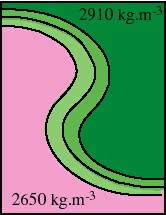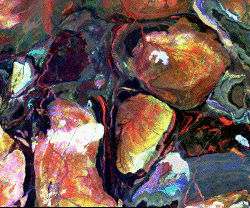|
The blanketting effect of greenstones cover ...and its mechanical consequences |
|
|
|
The average density of the greenstones is about 2910 kg.m-3 much higher that the average density of the granitic basement 2650 kg.m-3. Beside this density inversion, thermal softening following the greenstones emplacement makes the basement much weaker. This configuration results in the developement of gravitational instabilities where the denser greenstone cover sink into the weak and partially melted felsic basement. The final structure corresponds to a succession of granitic domes and synformal greenstone basins. The picture below is a line drawing of a physical experiment done in laboratory using rock analogue material such as silicone and wax. The pink layer is less dense that the green layer. This system is gravitationaly instable... |
|
|
|
 |
|
|
 |
|
|
|
 |
|
|
| The scale of these instabilities is in good agreement with the size of observed granitic domes in many Archaean craton such as the Pilbara (WA) as shown on the picture on the left. This image is a radiometric image. It shows the near surface distribution of heat producing elements (U, Th, K). The bright area are granitic domes, whereas the dark area are greenstone belts. |
|
|
|
|
|
|
|
|
|
|
|
|
|
|